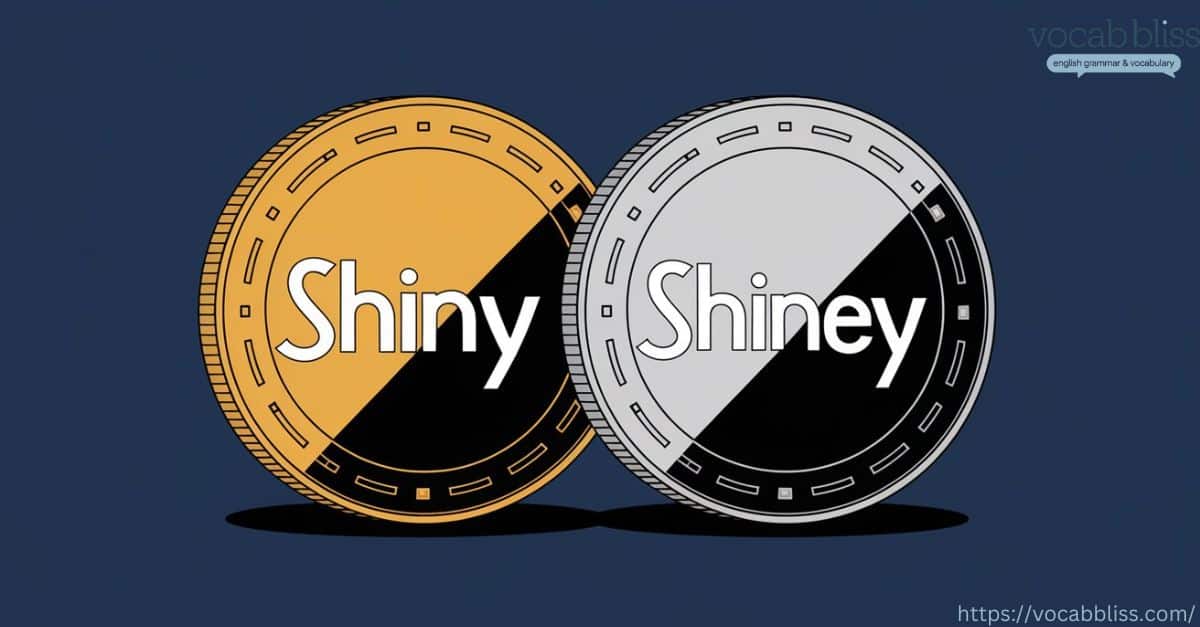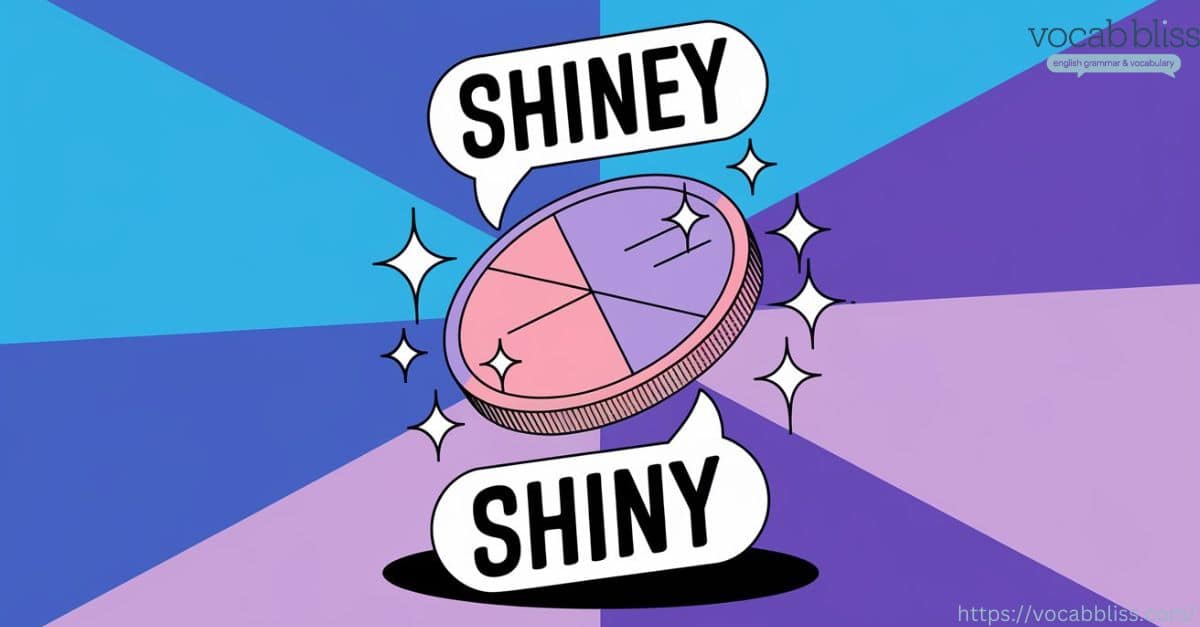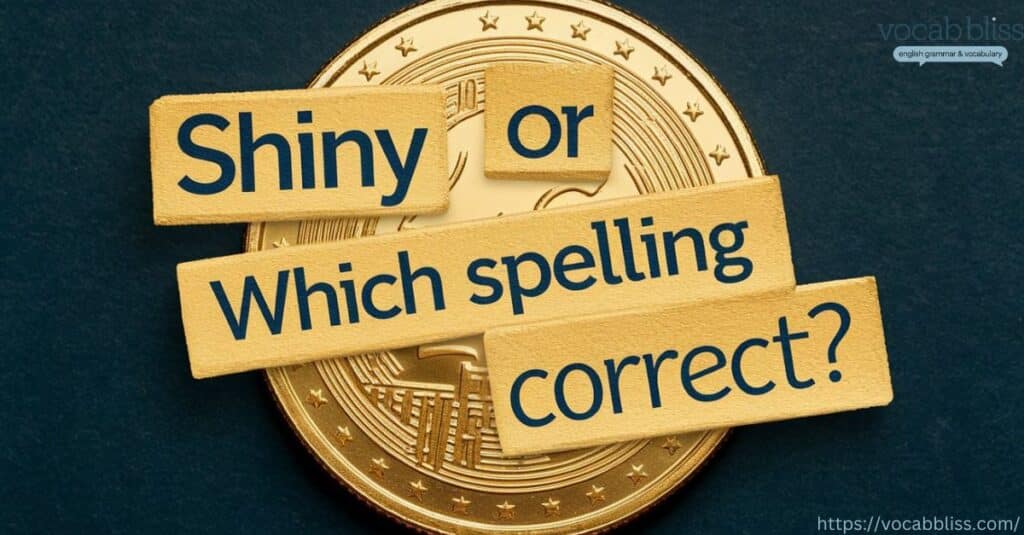When it comes to English spelling, even native speakers often struggle with certain words. One of the most common spelling dilemmas is whether to write “shiney or shiny.” Both may look correct at first glance, but only one of these is standard English.
This article dives into the specifics of the correct spell shiny or shiney ,” its usage, and why “shiney” is a common misspelling. Let’s explore what makes this word shine in the English language and why understanding correct spelling can enhance both professional and everyday communication.
The Basics: Shiny or Shiney
Shiny: The Correct Spelling
Shiny is the correct and standard form of the adjective derived from the root verb “shine.” According to standard English, “shiny” is used to describe things that reflect light or appear glossy, polished, or bright. The ending “-y” here follows a standard pattern in English for adjectives.
Definition of Shiny
“Shiny” is an adjective that describes an object or surface that is bright, polished, or reflective.
Typical Usage and Examples
Shiny objects are everywhere in our daily lives. We describe items like cars, floors, shoes, trophies, and even hair as “shiny” when they gleam or reflect light. Here are some examples of how “shiny” is used in sentences:
- “After washing and polishing, the car was so shiny that you could see your reflection in it.”
- “His shoes looked shiny and new after a thorough polish.”
- “The trophy gleamed under the lights, shiny and bright.”

Usage Tip
“Shiny” should be your default spelling in any type of formal or informal writing when you want to describe something polished, reflective, or gleaming. Using “shiny” will make your writing consistent and professional.
Shiney: The Common Mistake
Spell shiney may look like it fits, but it’s actually an incorrect spelling. Although it’s not a word in standard English, “shiney” is a common misspelling due to confusion around the “-y” and “-ey” endings.
Why Does This Happen?
In English, we have adjectives like “whiney” that use an “-ey” ending, which may lead people to believe that “shiney” follows the same pattern. However, “shiny” is an exception to this trend. English can be tricky with these inconsistencies, but knowing the root word (shine) helps to understand why “shiny” is the correct spelling.
Incorrect Examples of Shiney in Sentences:
- “The new floor was incredibly shiney.” (Incorrect)
- “After waxing, the shoes were so shiney that they looked brand new.” (Incorrect)
To prevent misspellings, remember that “shiny” directly links to the verb “shine.” Just like “shine,” “shiny” keeps a simple “-y” ending without any extra letters.
Grammatical and Etymological Breakdown
Shiny: A Deeper Look at Its Origins

To understand why “shiny” is correct, it helps to look at word formation in English. “Shiny” comes from the verb “shine,” following a common rule where adjectives are formed by adding a “-y” suffix to a base word.
Root Word: Shine
The root word shine is a verb meaning “to emit or reflect light.” When creating an adjective from this verb, English typically adds “-y” directly after the base word. This follows the pattern of other adjectives like “dusty,” “cloudy,” and “windy,” which all describe a quality related to their respective base nouns or verbs.
Etymology Table
| Word | Type | Meaning |
|---|---|---|
| Shine | Verb | To emit or reflect light |
| Shiny | Adjective | Reflecting light; polished; glossy |
Why “Shiney” Doesn’t Work: A Linguistic Perspective
From a grammatical standpoint, “shiney” violates the standard English spelling pattern for words with “-y” endings. Here’s why:
- Standard Form Rule: Words ending in “e” often drop the “e” when adding “-y” (e.g., love → lovely). “Shine” follows this rule by becoming “shiny.”
- Exceptions Are Rare: While English has a few words with an “-ey” ending, such as “honey” and “money,” these are mostly nouns, not adjectives. As an adjective, “shiny” does not follow the noun-based “-ey” pattern.
By understanding these grammatical rules, you can avoid common misspellings and develop a clearer grasp of English patterns.
Side-by-Side Comparison
Below is a comparison table to clearly illustrate the correct and incorrect spellings, meanings, and examples of each form:
| Spelling | Correct/Incorrect | Part of Speech | Definition | Example Sentence |
|---|---|---|---|---|
| Shiny | Correct | Adjective | Reflecting light; glossy | “Her hair looked shiny and well-maintained.” |
| Shiney | Incorrect | – | Not a word in standard English | “His shoes were shiney after polishing.” (wrong) |
The table above makes it simple to see the difference between “shiny” and “shiney” at a glance. Use “shiny” as the standard spelling, and avoid “shiney” entirely.
Everyday Usage Examples shiny vs shiney

Using “shiny” correctly is crucial to maintaining clarity in both professional and casual writing. Here’s how “shiny” works in various everyday contexts.
Correct Examples of Shiny in Sentences
- “The table was polished to a shiny, spotless finish.”
- “The trophy gleamed under the lights, looking shiny and new.”
- “A shiny, polished surface always leaves a good impression.”
- “Her hair was so shiny it looked like it had been freshly conditioned.”

These examples show how “shiny” applies to objects that reflect light or appear glistening or glossy.
Incorrect Use of Shiney
While “shiney” is common, it’s always considered incorrect in standard English. Here’s how not to use it:
- “The car looked shiney after the wash.” (Incorrect)
- “Her hair was shiney and smooth.” (Incorrect)”
Why Spelling Matters: The Importance of Accuracy
In English, spelling accuracy is essential for effective communication, especially in professional or educational settings. A single misspelling, like “shiney,” can impact your writing’s readability and credibility. Here’s why:
How Spelling Affects Communication
Misspelling a word might seem trivial, but it can create confusion or give the impression of carelessness. This is particularly true for writers, teachers, students, and professionals, where spelling mistakes can impact perceived expertise.
Example: In a professional setting, sending an email about a “shiney surface” on a product could reduce your credibility, especially if clients or colleagues notice the error.
Why It’s Important to Stick to Standard English Spellings
Following standard spelling conventions makes your writing clearer and easier to understand for a broad audience. Standard forms like “shiny” are universally recognized, which means that everyone who reads your work will understand what you mean without needing to decipher an unusual spelling.
- Professional Context: Using “shiny” instead of “shiney” in a resume, report, or product description signals professionalism.
- Educational Context: For students, mastering correct spelling helps in assignments and exams where accuracy counts.
Conclusion
Mastering the correct spelling of words like “shiny” may seem like a small detail, but it’s an essential part of clear and effective communication. Here are the key takeaways:
- Shiny is the correct and standard spelling for describing something reflective or glossy.
- Shiney is an incorrect spelling, commonly mistaken because of similar words that end in “-ey.”
- Understanding the root word “shine” and following standard English word formation rules helps prevent misspellings.
- In professional and educational settings, correct spelling reflects credibility and attention to detail.
By remembering the pattern that adjectives formed from verbs typically add a “-y,” you’ll be less likely to make this common spelling mistake. So next time you describe a brightly polished car or a gleaming trophy, you’ll know that “shiny” is the correct choice.
Incorporating accurate spelling, especially in simple words, not only improves your writing but also strengthens your credibility in all forms of communication. Let’s keep our writing spotless and shiny by mastering these small but significant details!
Dive Deeper:
- Oversight vs Oversite: Pointing Out the Differences
- Cheff or Chef: Understanding the Difference
- Using or Useing: Common Spelling Mistake Explained
- Nosy or Nosey? The Great Debate
- Usage or Useage: Which Is Correct and Why?

Jorge Phillips is an experienced blogger who writes for Vocab Bliss, sharing his passion for the English language. With a knack for simplifying complex grammar rules and a focus on commonly confused words, Jorge helps readers navigate the nuances of English with ease. His insights aim to make learning engaging and practical.







